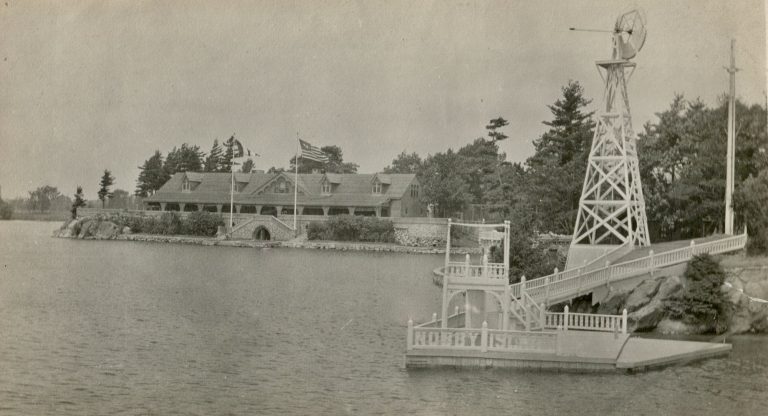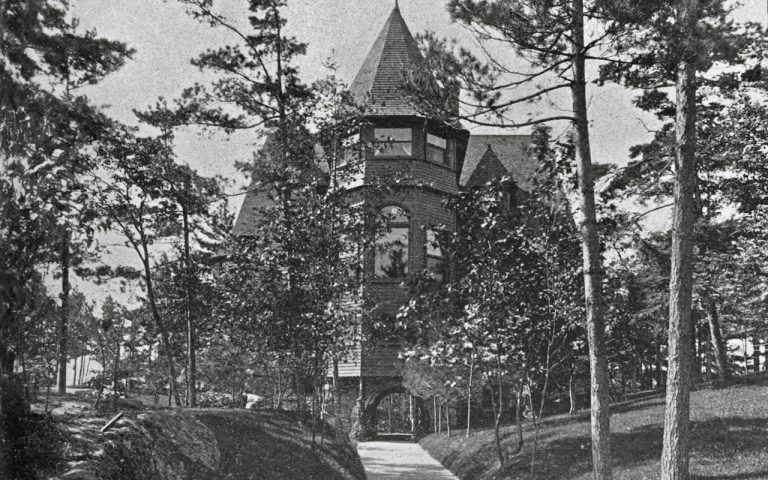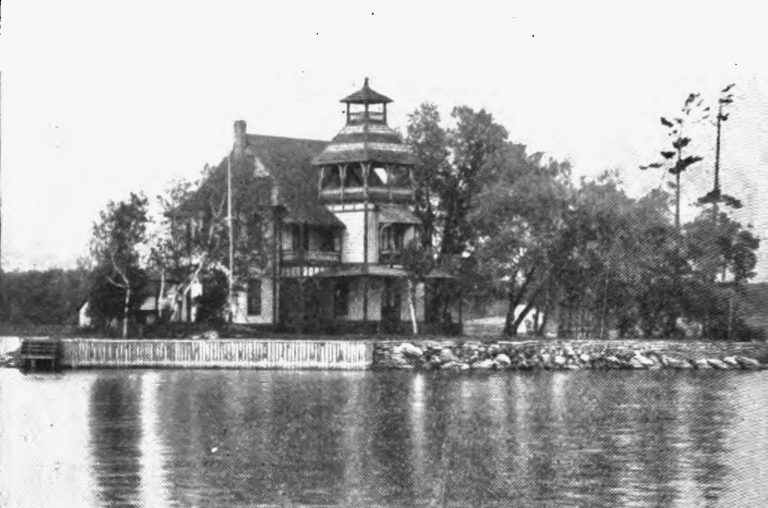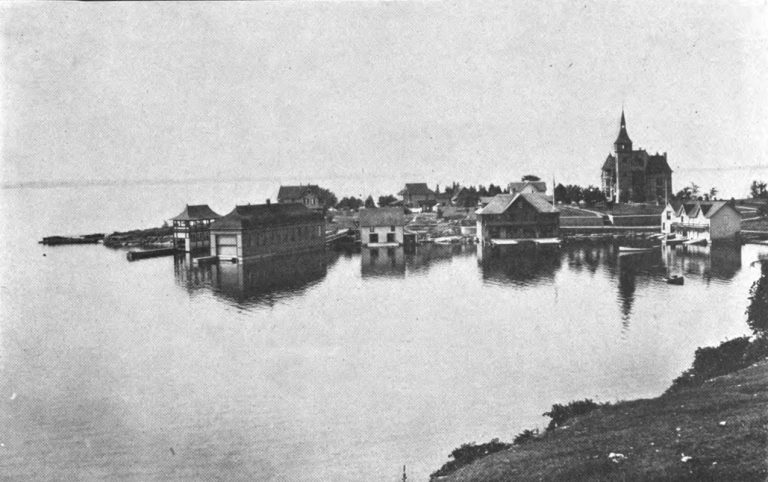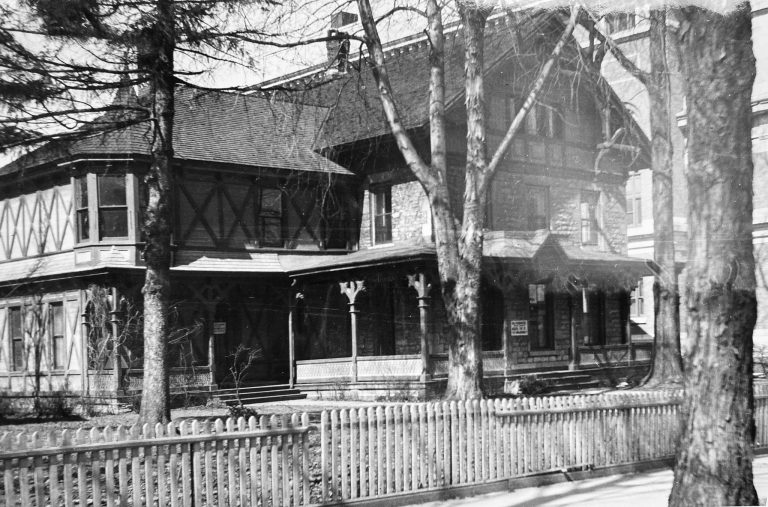Nobby Island: Henry Heath’s Vision of Utopia in the 1000 Islands
The “recorded” history of Nobby Island begins with George Pullman having purchased it along with one of its neighbors that would become Pullman Island. Pullman would invite Henry Roswell Heath to the island in 1868 to help recover from a spell of bad health (some references note 1870). Having found the region to be an ideal location, Heath, from Brooklyn, would soon purchase the island with fellow New Yorker Charles S. Goodwin and erect a cottage in 1872.

In retrospect, Heath would be credited with drawing many of the wealthy islanders to the region, perhaps due in part to the Island’s good-natured times to be had by all. This was evident in an article published in the Watertown Daily Times that was quite extensive for its time, having been printed in July of 1873–
Who Are Stopping There–What They Do!
One of the pleasantest, most prominent, most lively and most cheerful of all the “Thousand Islands,” is Nobby Island, situated a little above the village of Alexandria Bay, about a half mile distant. It does not escape the notice of a single visitor to this popular resort, on account of its pleasant prominence to one approaching the Bay.
It attracts the attention of all who pass it, and the look of solid comfort which it throws out when occupied by its company of pleasure seekers, wins the the admiration, and excites the envy of those who would enjoy for a few weeks the comforts of a charming island home.

Its History
Four years ago, in 1869, before the popular demand for the islands fairly begun, this island won the special admiration of two gentlemen friends, Messrs. Henry R. Heath, of N.Y. City and Charles S. Goodwin, of Oneida, N.Y. As a result of their good taste, they decided to purchase and own the island, and resolved to make it a private summer home for themselves and friends.
The price paid was $100, which now could be a meager figure, and represents only one fiftieth of its present valuation. After becoming its fortunate possessors, Messrs. Heath and Goodwin erected upon it a good Gothic cottage, suitable for the accommodation of twelve or fifteen persons.
They also erected flag staffs and mounted one piece of cannon, which latter article reminds the country around of the return of each season, and which seems to have eyes, so quickly does it discern an approaching boat, and hasten to give its welcome in a voice of thunder. Those only who pass by are honored with one of these ringing salutes, can realize the heartiness of the good feeling, the hospitality and courtesy that seem to have taken possession of the island with the proprietors.

The summer of 1871 would see Nobby Island populated by a dozen personal friends, giving the notion of being the first summer resort in the 1000 Islands as the new tradition was repeated the following year. The Times noted, “Friends thronged to its shores in great numbers, greater than the limited accommodations would afford.”
Indeed, it was argued that the season was so well enjoyed it rivaled Pullman Island’s visit by President Ulysses S. Grant. The Daily Times would say of the summer on Nobby Island, “All who visited the Bay came away with the pleasant memories of Nobby Island lingering perpetually about them.” It was quickly decided a second cottage was needed, and therefore erected, along with purchasing a steam yacht, several small boats, and other amenities.

Despite the additional cottage, the large number increase would dictate the party to be split up: Heath and his friends would occupy Nobby Island from July until sometime in August when Goodwin’s party would arrive to join in the season’s entertainment and festivities. Those without accommodations would end up at the Crossmon or the newly constructed Thousand Island House, if not altogether, as guests on another island.
One of the earliest improvements Heath and Goodwin made was to drill holes in the rocks for iron bars and made a platform reportedly 20 x 40 feet connected to the island by a bridge. The Times would note, “Many of the party are often found in this spot, discussing the politics and fashions of the day, and rolling out bass enormous size, which later are discussed afterward around a pleasant table.”


The Mystery of the “Very Large” Skeletons Unearthed On Nobby Island
In 1884, Henry Heath would become the sole owner of Nobby Island and would have Seth G. Pope begin construction of an additional “Gothic” cottage, dock, and boathouse. In excavating the land, he would come across six skeletons that, later reports would note as being “Very large” and with cheekbone structure to be Native American.
The Watertown Daily Times would run a piece on May 28th, discussing the mystery–
The mystery regarding the six skeletons dug up on Nobby Island three weeks ago is as deep as ever. A physician of Alexandria Bay who asked to see the skulls in order to determine whether they were aboriginals or not, was denied that privilege and received a strong hint that his room was better than his company.
It has been ascertained that they were put into one box and buried, but where is a question yet to be answered. The whole affair seems to be shrouded in mystery. Who they were and why the finding of them should be so suddenly hushed up, are questions which agitate the minds of the good people of Alexandria Bay.
Two days later, another brief article would run, and the Times would note, “The discovery of this ancient burying ground and the mystery that surrounds it would seem to make Nobby Island an uncanny place to live, but, perhaps Mr. Heath is not one of the superstitious sort.” Ironically, it was said that Seth Pope was indeed superstitious and would not continue work until the remains were buried again.

In 1889, Mr. Pope would begin building “an elegant new cottage on the property,” according to the Daily Times. In later years, it was referenced, and noted later, that the manor house was built in 1894; I’m not sure if this is the same one referenced or which date is correct. By 1891, it was estimated that Heath had spent $50,000 on improvements to Nobby Island.
In April of 1908, Henry Heath passed away, and the details of his will would be published in the news–
New York, April 23 — Henry Roswell Heath, in his will, which has been filed for probate in the surrogate’s office, Brooklyn, claims the distinction of having been the first to erect a modern summer cottage in the Thousand Islands. The cottage was erected on Nobby Island in 1870. It is bequeathed to the widow, Jane B. W. Heath, with the request that she give it to Norman Abijah Heath, their only son, when she tires of it.
The son will receive all the jewelry and sporting articles, including steam launches and pleasure boats, Owen and Cleopatra Islands. Stanley Heights on Willsley Island and the farm on Wells Island, which is known as Lakewood and contains several buildings and greenhouses.
In addition to the the son gets the home at 560 Washington Avenue, Brooklyn, 19 acres of land in Lakewood, N.J., extensive of real estate in Virginia and New Jersey, a certificate (value not given) in the Cranford (N.J.) Mutual Building and Loan association, all the money on deposit in the Seaman’s bank in Manhattan and $40,000 worth of stocks to be selected by the beneficiary from the holdings of the testator.
The residue of the estate, including the buildings and lots in Cranford, N.J., is left to the widow.
The testator says that he would have made yet more liberal provisions for her had she no been wealthy in her own name and the beneficiary to a large amount in her grandfather’s will. Small bequests were made to charity, distant relatives and old employees.

The history of Nobby Island for the next few decades is sparse, at best, and somewhat confusing partly because the local newspapers would occasionally add a “K” and make it Knobby Island. During the 1920s, the island would have the “Jenney” name attached to it.
The property would appear for a tax sale in 1937, belonging to the R. H. Heath Estate. Whether it was meant to be H. R. Estate is unknown; their only son, Norman, had died two years previously and had lived in Los Angeles since 1914. The taxes would be caught up but would return to the list in 1940. In 1941, Kapell & Company purchased it.

At some point thereafter, William L. Clay, an attorney from Rochester, would purchase Nobby Island. Mr. Clay acquired several properties in the 1000 Islands, including part of Grenadier Island, which included Moro Castle, Murray Isle, and Deer Point on Wellesley Island from Clover Boldt Johaneson.
The property would stay in the Clay family until it was sold by William Clay, Jr. and Henry N. and Barbara C. Ryan to Dr. John and Beverly Merola of Cazenovia, who, according to the Daily Times, was “Dedicated to restoring the house and cottage to their original ‘Victorian’ conditions.”

In 1991, the cottage would be part of the Thousand Island Cruise and Tour to benefit the local hospital in Alexandria Bay. In 2009, work would begin on an entertainment pavilion that would win First Niagara Bank’s “A Time To Build” award for historic preservation projects. The details of the project, from the Daily Times–
The three-story structure was built on a rocky side of the island, where there was no bedrock. It took three months of drilling pipe piles to create a foundation to start the work.
“That was our biggest challenge,” Aubertine and Currier partner Brian A. Jones said after the award luncheon Thursday in Syracuse.
“Our other challenge was that everything had to look like it was built back in the 1880s. Everything was customized, from the handrails to the fireplace,” he said.

The owner, Dr. John Merola, wanted the project to reflect the aesthetics of the main house and included a grand dining room and kitchen, while the pavilion itself has unobstructed views of the water.
Dr. Merola “wanted this to be done right and he wanted something to be used for generations,” Mr. Jones said. “Projects of this magnitude are not built very often on the river, so I am happy to have this opportunity.”

Numerous amazing photos of Aubertine and Currier’s well-deserved winning preservation project can be viewed in the video below from A Boy and His Dog Productions (Patrick Ryan) YouTube channel showing an aerial tour around Nobby Island via a drone filmed in May of 2016.




